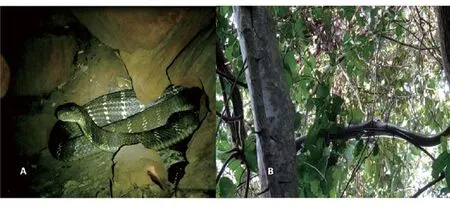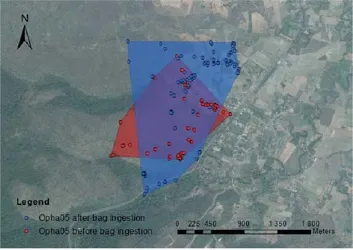Mortality of a Wild King Cobra, Ophiophagus hannah Cantor, 1836 (Serpentes: Elapidae) from Northeast Thailand after Ingesting a Plastic Bag
*
1Suranaree University of Technology, Nakhon Ratchasima, Thailand
2Sakaerat Environmental Research Station, Nakhon Ratchasima, Thailand
3School of Natural Resources and Environment, University of Arizona, Tucson, Arizona, USA
Mortality of a Wild King Cobra, Ophiophagus hannah Cantor, 1836 (Serpentes: Elapidae) from Northeast Thailand after Ingesting a Plastic Bag
Colin Thomas STRINE1, Inês SILVA2, Matthew CRANE1, Bartosz NADOLSKI1, Taksin ARTCHAWAKOM2, Matt GOODE3and Pongthep SUWANWAREE1*
1Suranaree University of Technology, Nakhon Ratchasima, Thailand
2Sakaerat Environmental Research Station, Nakhon Ratchasima, Thailand
3School of Natural Resources and Environment, University of Arizona, Tucson, Arizona, USA
Wild King Cobras, Ophiophagus hannah, are known to prey almost exclusively on snakes. We observed opportunistic ingestion of a plastic bag by a radio-tracked adult male O. hannah, which was detrimental to the health of the individual and likely lead to its death. Our observation demonstrates that improper disposal of food and plastic waste can be a threat to snakes, highlighting the need to maintain a waste-free environment, especially in areas inhabited by vulnerable species.
Garbage, Sakaerat, Snake, Waste, King Cobra, Ophiophagus hannah
The King Cobra (Ophiophagus hannah) is the longest venomous snake in the world, reaching lengths of greater than 5 m. Part of a monotypic genus in the family Elapidae, O. hannah is thought to primarily prey on snakes and certain species of lizards (Chanhome et al., 2011), and some individuals may develop a specialized diet, at least seasonally, as was the case with an adult male in India that selectively hunted for pit vipers (Bhaisare et al., 2010). In the wild, O. hannah exhibits active foraging behavior, expending a large amount of time searching for prey odor trails, which are usually revealed by increased tongue fl icking and scent tracking (Bhaisare et al., 2010). Assessed as Vulnerable (IUCN Red List), the species has a wide distribution (mainland India, southern China and throughout Southeast Asia), but appears to be uncommon throughout its range, likely attributable to habitat destruction and fragmentation. Although O. hannah prefers undisturbed primary forests, especially for nesting, it is commonly found in human-dominated habitats, such as agricultural fi elds, degraded forests and near human residences. Pollution, in the form of solid plastic waste, is common in these ecologically degraded areas, and previous studies have documented the entanglement of terrestrial snakes in synthetic materials, such as nets, plastic and metal fencing (Miranda, 2013). Lizards have also been known to consume plastic waste, and plastic bags containing meat seem to be particularly attractive to large carnivorous species (e.g., Varanus varius; Gillett and Jackson, 2010). Because plastic is extremely durable, it easily accumulates in ecosystems. Consumption of plastic can result in impaired movement and feeding, reduced growth, and even death, perhaps due to starvation or suffocation (Miranda, 2013). This note represents the fi rst reported case of a wild O. hannah consuming plastic waste, and the first reported case of any snake species consuming plastic.

Figure 1 A: Adult male Ophiophagus hannah showing good body condition with the lack of a neural arch, and obvious fat stores after ingesting a monitor lizard in early August, indicating that the snake was hunting and healthy in August, 2013. B: Adult male O. hannah on 23 August, 2013, displaying arboreal hunting behavior, lacking any evidence of skin folding.
On 25 October 2013, we observed a healthy radio tracked adult male O. hannah (total length = 445.4 cm, mass = 6.2 kg), which we had been radio tracking at least daily for the previous 126 days (Figure 1), ingesting an opaque plastic bag filled with unknown contents. We carefully observed the snake to minimize disturbance, recording the event with a “point-and-shoot” camera at a distance of 1 m–2 m. The event occurred at 1655 h under a large patch of mixed vegetation, approximately 6 m wide and 3 m tall, in the margin between a cassava field and a small village located within the buffer zone of Sakaerat Biosphere Reserve, Nakhon Ratchasima Province, Thailand (14.5130°N, 101.9562°E, datum: WGS84, elev. = 246 m). The forested reserve area covers approximately 80 km2, with an elevation range of 250 m–762 m. The dominant forest types are dry evergreen forest (dominated by Hopea ferrea) and dry dipterocarp forest (dominated by Shorea obtusa and Pentacme suavis at the canopy level), which represent ~78% of vegetation types present in the Reserve. Other habitats include bamboo, plantation forests and sparse grasslands; areas surrounding the reserve are mostly comprised of extensive agricultural fi elds and human settlements.
We video recorded consumption of the bag (available on request), which consisted of the snake twisting its head left to right, as it pulled the bag into its mouth. The “jaw walking” behavior occurred in bouts that lasted 6–14 seconds per bout, with the snake positioning the bag for ingestion. At the time of ingestion the snake showed no evidence of skin folding, nor were neural arches visible as prominences beneath the dorsal skin. We inadvertently disturbed the snake, at which point, it gaped, quickly moved its head back, and advanced toward the observers. The observers retreated, and no further behaviors were recorded. After the snake moved away, we searched the site for 4 h. We did not fi nd the bag, confi rming that the snake had successfully ingested it. We did not capture the snake, because it was a study animal. For the next two days, the snake remained in the same shelter site (beneath a rock in an old mammal burrow), apparently exhibiting post-ingestion behavior.

Figure 2 MCP area for the 44 days before consuming the bag, and the 44 days leading to the death of the Ophiophagus hannah. The larger area (blue) represents after the predation event. The smaller area (red) is the period before the bag ingestion. The map suggests a change in movement pattern after the king cobra ingested the bag.

Figure 3 Adult male Ophiophagus hannah basking near the shelter site, with very poor body condition shown by the evident neural arch, and very obvious skin folding from November 2013. Photo by Bartosz Nadolski.
There was an obvious shift in movement patterns before and after the snake ingested the plastic bag (Figure 2). We tracked the snake for 44 days after it swallowed the bag. During the fi rst 25 days, the snake moved every day for a total of 9659 m. During the fi nal 19 days, the snake only moved two days, 327 m and 27 m, respectively. For the 44-day period preceding ingestion, and the 44 days leading up to the mortality, we calculated activity ranges using the Active Kernel method in Program R for statistical computing. The 95% kernel home range estimate was smaller before (1.20 km2) ingestion of the bag than after (1.79 km2); the 50% core area was also smaller before (0.19 km2) than after (0.34 km2) ingestion of the bag. Movement patterns changed after the incident, it is likely the snake was attempting to forage intensively (unsuccessfully) in preparation for the cold season, we recorded no further predation events, but observed active foraging behavior.
We observed rapid deterioration in the snake’s body condition, as indicated by obvious loss of mass and the appearance of large skin folds. The neural arch also became more prominent over time (Figure 1; Figure 3), indicating atrophy of surrounding muscle tissue. On 12 December 2013, we found the snake dead under a large overhanging rock. Using a camera attached to a USB cable we were able to confirm that the snake was dead, however, we were unable to retrieve the snake’s remains for post-mortem examination.
Our observation represents the first report of plastic waste ingestion by any snake species. As such, it indicates that ingestion of plastic waste may be an overlooked source of injury and mortality, not only to O. hannah, but to other snake species as well. Although the frequency and potential effects of ingesting plastic, or other types of waste, are not fully understood, the behavior may be deserving of greater attention. In addition, this observation highlights the potential importance of plastic waste management, particularly where wildlife are known to occur.
Bhaisare D., Ramanuj V., Shankar P. G., Vittala M., Goode M., Whitaker, R.2010. Observations on a Wild King Cobra (Ophiophagus hannah), with emphasis on foraging and diet. IRCF Rept Amphib, 17(2): 95–102
Chanhome L., Cox M. J., Vasaruchapong T., Chaiyabutr N., Sitprija V.2011. Characterization of venomous snakes of Thailand. Asian Biomed, 5: 311–328
Gillett A., Jackson R.2010. Human food scrap ingestion in two Wild Lace Monitors Varanus varius. Biawak, 4(3): 99–102
Miranda J. P., de Matos R. F., Araújo R. C. S., Scarpa F. M., Rocha C. F. D.2013. Entanglement in plastic debris by Boa constrictor (Serpentes: Boidae) in the state of Maranhão, Northeastern Brazil. Herp Notes, 6: 103–104
*Corresponding author: Dr. Pongthep SUWANWAREE, from Suranaree University of Technology, Nakhon Ratchasima, Thailand, with his research focusing on environmental quality, invasive species and wildlife ecology in Lao and Thailand.
E-mail: pongthep@sut.ac.th
Received: 2 June 2014 Accepted: 25 November 2014
 Asian Herpetological Research2014年4期
Asian Herpetological Research2014年4期
- Asian Herpetological Research的其它文章
- Population Dynamics Following the Last Glacial Maximum in Two Sympatric Lizards in Northern China
- A New Species of the Genus Thermophis (Serpentes: Colubridae) from Shangri-La, Northern Yunnan, China, with a Proposal for an Eclectic Rule for Species Delimitation
- Group-spawning and Simultanous Polyandry of a Stream-dwelling Frog Feirana kangxianensis
- Can an Invasive Prey Species Induce Morphological and Behavioral Changes in an Endemic Predator? Evidence from a South Korean Snake (Oocatochus rufodorsatus)
- Food Habits and Distribution of the Lake Taal Sea Snake (Hydrophis semperi Garman 1881) and the Sympatric Little File Snake (Acrochordus granulatus Schneider 1799) in Lake Taal, Philippines
- Body Size and Reproductive Tactics in Varanid lizards
